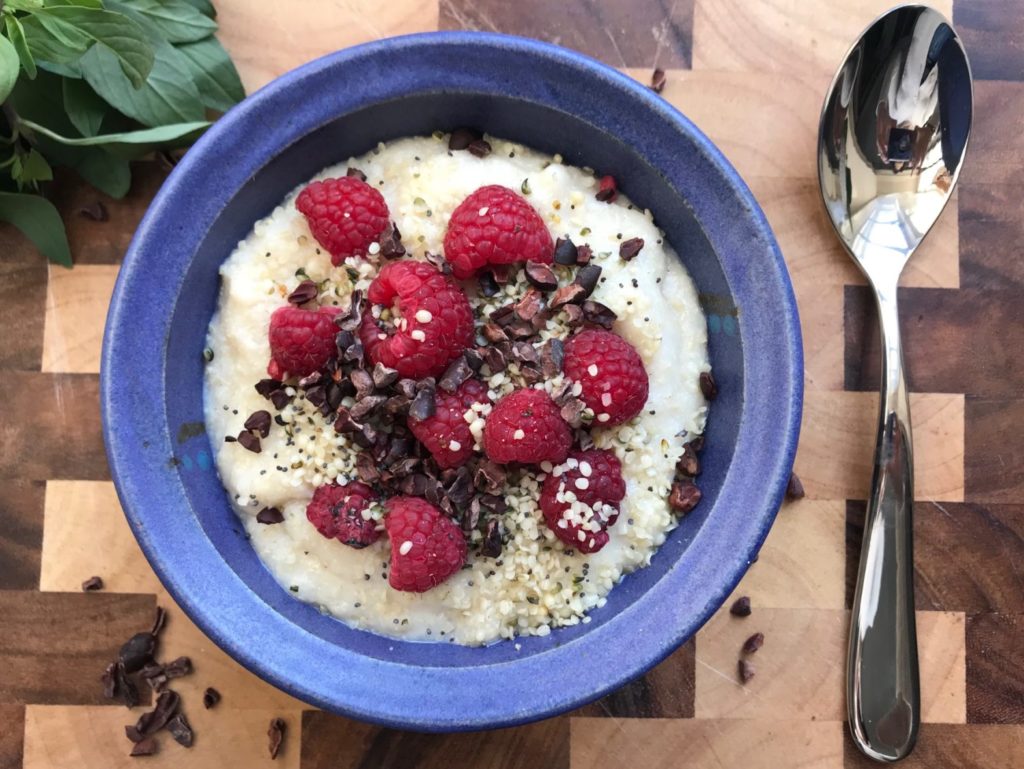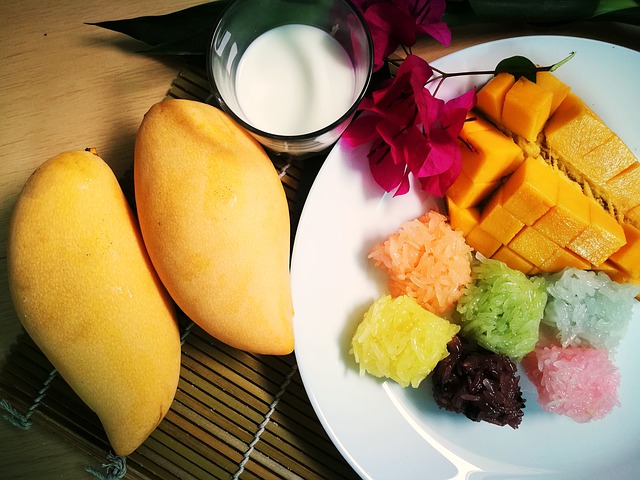
Image by Sasin Tipchai from Pixabay
Many of us with IBS or SIBO find that rice is usually doesn’t trigger our symptoms – but is it low FODMAP and is it OK to eat or not? I thought I’d do some digging and find out.
The answer, it seems, is not as straightforward as I expected it to be! Some types of rice are low FODMAP and others are not – and it depends on when you eat it after you’ve cooked it. Sticky rice turns to glucose straight away and so, even in an inflamed gut, is likely to be absorbed high up in the digestive tract, before it has a chance to reach any microbes and cause symptoms. Other types of rice like Basmati and brown rice take longer to digest and are more likely to cause problems.
Why are some varieties of rice digested quicker than others?

Image by Sasin Tipchai from Pixabay
White rice is almost pure starch, and starch is made of thousands of glucose molecules strung together. It turns out that the starch in different varieties of rice has different structures. Rice starch can be branched [amylopectin] or made of long, linear chains [amylose].
For digestion, this makes a big difference! Rice with a higher proportion of branched starch like sticky rice is more quickly and easily digested than Basmati rice that has more long straight chain starch.
So although technically rice is a starch and therefore a fodmap, because it is absorbed very early in digestion, it is ok for many people with SIBO type IBS.
So if you’re thinking of a low fodmap lunch, go for sticky rice, like sushi rice and Thai rice.

Image by Robert-Owen-Wahl from Pixabay
But I thought rice – or any grain – was not recommended on a low-FODMAP diet…
Starch is usually forbidden on low FODMAP diets, and if you’re like me, you will miss the wonderful comforting ‘stodginess’ of carbs such as rice. Given that many people with IBS have imbalanced microbes towards the end of their the small intestine or in the large intestine, starch that is quickly digested and absorbed should be tolerated easily. Of course, this is unlikely to be the case if you have overgrowth in your stomach or early in your small bowel.
Does how I cook rice make a difference?
Yes. Rice that has been heated and cooled will start to form resistant starch (RS). RS is a great food for microbes and always touted as ‘good for your gut’. But this doesn’t take into account those of us with SIBO! If RS is good for microbes it is also, therefore, a fodmap.
I’ve heard of resistant starch – what is it?
When some starches are heated and then cooled, the starch of which they are made starts to change to a structure that is ‘resistant’ to breakdown by our digestive enzymes, and so hangs around ready to feed our microbes. The more rounds of heating and cooling the rice goes through, the more RS is formed. So if you have SIBO, then my advice is to eat it hot, or cooled the next day in sushi – but don’t reheat unless you’re sure you can tolerate it without symptoms.

How can I test whether resistant starch is a problem for me?
First, introduce it after a period of strictly eating foods you can tolerate so that you have a calm background on which to test RS.
Second, eat it a once or twice a day for 2-3 days and keep a symptom diary. This is crucial because symptom slide tends to happen slowly and it is easy to forget how you felt one or two days ago.
Third, if you happen to have a mobile breath hydrogen tester, you can use this to see if the fermentation in your gut has gone up.
What other starches are generally well tolerated by people with SIBO or IBS?
Floury potato is another veg that is very easily digested into glucose which is absorbed high in the digestive tract. But, as with rice, take care with cooling and reheating as this will form resistant starch.
Gluten free bread tends to be made with rice and tapicoa starch mixes, which are easily digested – BUT, these breads often contain gums, fibres and inulin that can raise the FODMAP profile – to approach with caution and try small amounts first.
There are several other grains and pseudo grains that are often well tolerated by those of us with SIBO, but you will need to check and see if they agree with you and your personal physiology and stage of recovery. These include:
- Quinoa
- Amaranth
- Buckwheat
- Millet
Warming and comforting low FODMAP breakfasts
Isn’t porridge or oatmeal the ultimate comfort food breakfast? Many of us avoiding FODMAPs can miss this wonderful winter staple.

Just like a plant based diet opens up so many options for milk [hazel, oat, hemp, rice, almond, tigernut…etc], so although ‘normal’ oat porridge is out, we will discover the many other delicious options out there!
For speed on busy week-day mornings, I tend to use flakes: rice flakes, millet flakes or quinoa flakes and add my favourite plant milk of the moment and some cinnamon and nutmeg. These cook in around 10 minutes and if you get the porridge on as soon as you come downstairs, it will be ready by the time you’ve made your morning coffee or tea.
If you have a rice cooker that has a timer, you can set your porridge up the night before and come down to wafts of warming spices, and ladle steaming, fragrant porridge out to your family. Oh, how to feel like a domestic goddess!
Easy, portable low-FODMAP lunches
If, like me, you’re busy, you need easy lunches that dont require much thought. I usually follow a simple and easy formula that doesnt need a cooker or microwave.
Take a lunch container and add:
- a base of higher protein carb (like quinoa, rice, millet, amaranth)
- a bunch of greens (steamed kale or broccoli, lettuce, cucumber, celery).
- Optional: add some low FODMAP protein
- In a separate container, include one of the LOVENUTTY white almond butter or tahini dressings.

Image by vinita beever from Pixabay
Just pour on when you’re ready to eat. And for dessert, why not try low FODMAP berries topped with nuts, seeds and coconut yoghurt?

